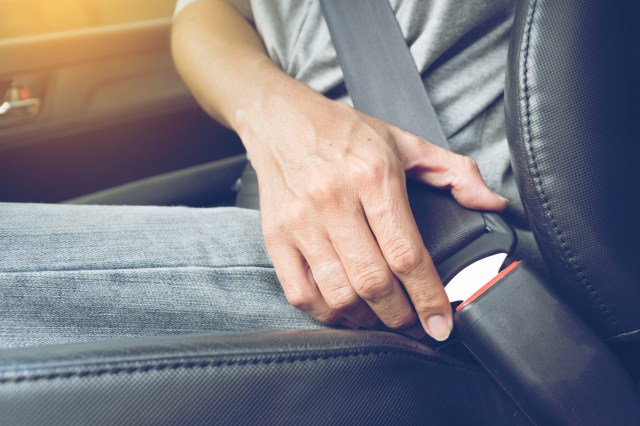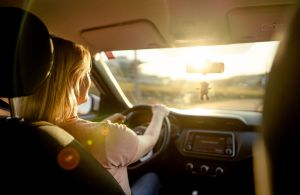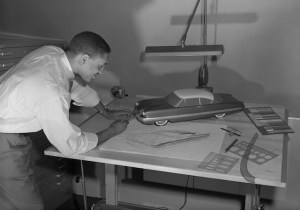We all have them. Whether it’s checking texts while driving, speeding, ignoring stop signs or failing to use turn signals, everyone has developed a bad driving habit or two. The problem is how to get rid of them.
While some of these may seem inconsequential, even the smallest lapses in concentration and judgement while driving can have fatal results. In 2024, about 44,680 people died in motor vehicle crashes in the U.S., the National Safety Council reported. About 3,308 people were killed in distracted driving incidents, according to the latest information from the National Highway Traffic Safety Administration (NHTSA).
The most recent AAA Foundation for Traffic Safety’s annual Traffic Safety Culture Index revealed that the majority of the 2,630 online survey respondents recognized risky driving behavior. For example, about 93% of drivers identified both texting/emailing and reading on a hand-held cell phone as very or extremely dangerous, while fewer drivers viewed holding and talking on a cell phone (78%) or using hands-free technology (16%) as very or extremely dangerous. Despite that level of awareness, 27% of drivers reported sending a text or email while driving, 37% read a text or email and 36% held and talked on a phone. The majority of drivers, 59%, reported using hands-free technology to talk, text or email.
The best way to avoid bad driving habits, of course, is not to start them. AAA Driver Training instructors do their best to impress upon young students the importance of following all the rules of the road. This includes not eating when driving and obeying speed limits and stop signs. Young drivers are encouraged to ignore drivers who honk at them for not coming to a complete stop at stop signs.
More seasoned drivers, who may be getting a little lax when it comes to traffic rules, need to remain vigilant and not slip into dangerous habits, like accelerating at a yellow light. Drivers who want to refresh their skills can sign up for the AAA Defensive Driving Course.
“One of the best ways to instill good driving habits is to explain why a regulation is important, and what can happen if you don’t follow it,” said Gary Driscoll, a AAA behind-the-wheel driving instructor in Cranston, R.I., and former police officer. “I stress situational awareness when driving.” Failure to pay attention even for a second could result in a life-or-death situation.
Distracted Driving
This is one of the most common and dangerous bad driving habits. Texting, talking on the phone, even talking to passengers, eating or listening to music are all distractions that could take your eyes of the road or cause you to lose focus.
One of the newest, and most dangerous, trends is shooting video while driving, especially with younger drivers trying to capture clips for social media. This takes your concentration almost completely off the road and your hands off the wheel. If you want to shoot a video from your car, do it while stopped in a parking lot.
How to Fix
Put your phone on do not disturb and out of reach, said Barbara Ward, a longtime traffic safety specialist with AAA Northeast. Texting while driving is one of the top bad habits to break. It raises the possibility of a crash because it creates a “triple threat,” according to Ward. “It takes a driver’s eyes off the road, hands off the wheel and mind off driving more than any other potentially distracting activity.”
Impaired Driving
Impaired driving includes getting behind the wheel after drinking alcohol or using marijuana. Driving while under the influence not only has serious legal repercussions, but puts the driver, passengers and everyone on the road in danger.
How to Fix
Don’t do it. Designate a sober driver ahead of time or call a taxi or ride-sharing service.
Drowsy Driving
Drowsy driving can be just as dangerous as impaired driving, yet 18% of respondents reported engaging in that behavior in the past 30 days.
How to Fix
AAA recommends stopping for a break every two hours or 100 miles while you are driving. If you start to nod off, have trouble keeping your eyes open or can’t recall the last few miles driven, pull over and let someone else take the wheel.

Speeding
While many drivers do not consider speeding risky behavior, speeding is a factor in one-third of vehicle fatalities. “Speeding gives you less time to react and increases the distance you need to stop,” Ward said.
How to Fix
Slow down. “Always know the posted speed limit and use cruise control, if possible, to keep the vehicle at a safe and reasonable speed,” added Ward.
Aggressive Driving
The NHTSA defines aggressive driving as a combination of moving traffic offenses that can endanger other people or property, often sparked by road rage. This includes one of the most infuriating bad driving habits, tailgating.
How to Fix
Avoid being a tailgater by staying calm if someone ahead of you is driving more slowly and keep a lighter foot on the gas pedal. If someone is tailgating you, continue driving the speed limit, remain calm and obey traffic signals.
More tips for dealing with an aggressive driver:
- Avoid eye contact with angry drivers.
- Don’t respond to aggression with aggression.
- If you feel you are at risk, drive to a public place such as a police station, hospital or fire station.
- When you park, allow room so you can pull out safely if someone approaches you aggressively.
- Use your horn to attract attention but remain in your locked vehicle.
- If you feel threatened, call 911.
More Bad Driving Habits
- Rolling through stop signs or not knowing when to stop for a school bus.
- Not slowing down and moving over for emergency vehicles – or any vehicle stopped at the roadside.
- Failing to wear a seat belt or use turn signals.
And there may be a few bad driving habits you might not even know you have, based on this story about bizarre state driving laws.
Learn more about at AAA Driver Training, available in Massachusetts and Rhode Island.
What bad driving habit drives you crazy? Share your thoughts in the comments below.
This article has been updated and republished from a previous version.
26 Thoughts on “Bad Driving Habits and How to Fix Them”
Leave A Comment
Comments are subject to moderation and may or may not be published at the editor’s discretion. Only comments that are relevant to the article and add value to the Your AAA community will be considered. Comments may be edited for clarity and length.


















As a Crossing Guard I see MANY bad driving “techniques”. I’m at a busy street with an adjoining street to the school. There are two crosswalks, and nearly 200 students going in three directions. Aggravating drivers: 1. Not stopping as I’m crossing students “Blind Driving”. 2. Speeding in a posted 20 mph zone. 3. Honking at me because they had to wait two minutes, then going as fast as they can when I signal them on. 4. Not stopping to let cars enter the traffic lane. 5. Driving down a restricted street to deliver their fully capable kids to the door of the school. 6. Yelling at me. 7. Telling me how to do my job!
I joke when I tell my supervisor at the PD, “Give me a paint gun!
Don’t forget bad pedestrian habits. How often do we see people crossing the street while looking only straight
Ahead. Also wearing very dark clothes at night. Could they not ride a bike or jog on the sidewalk. What about going right through an intersection without stoping at all while on a bike or battery scooter. Many years ago a young child on a bike path ran a bike path stop sign and was killed. Very sad. Mom and Dad were there and possibly not paying attention.
Pedestrian safety is often in their own hands.
This is not excusing bad driving by the way.
Pedestrian safety is often in their
Or looking at their phone as they cross the street!
I note speeding is in effect encouraged by road design that allows easy fast travel far over the posted speed limit, disrespect for stop signs due to a profusion of them on minor streets intended to slow traffic rather than a legit stop, allowing parking where it is makes it difficult to see entering traffic. So engineering solutions are also needed, including traffic signalization coordination that promotes steady slow travel to minimize both speeding and frequent stops
How about those roads that allow travel in the breakdown lane during peak commuting times? Drivers who use them are often speeding, driving even faster than cars in left lane. Those breakdown lanes should have lower speed limits when travel is allowed.
The most important action to prevent accidents is to keep plenty of distance to the car ahead. This will avoid most accidents caused by other bad drivers giving you enough time to react.
I just finished a round trip to TN and back to Long Island. I found the worse speeder were trucks. Most couldnt bother slowing down in construction zones
Drivers that pull to the right hand side of the lane to make a left turn and vice versa.
RI has more than their share of bad drivers. Tailgating is the number 1 complaint if you’re trying to follow the speed limit posted. Lane switching on the interstates is out of control and people still text or hold their phone to there ear while driving.
I just love to see someone driving with a dog in his or her lap, looking out the window. How can you drive with a dog in your lap???
When driving, be your own biggest critic. Road rage is a two part problem – those who cause it and those who exhibit it. Don’t be the person who causes it by going too slow in the left lane. Keep to the right except to pass and the second part of the problem never happens.
Yes, I have put 10 of 1000s of mile on a motorcycle in Europe. That is what makes their roads 100% safer.
American’s are the worst. They are so ignorant they think it is their right to block the left hand lane. Of course this is a police issue. Cops are only interested in writing speeding tickets, not cutting down driving habits that create a breeding ground for road rage. Blocking the left lane is the most dangerous maneuver a driver can make.
I agree! And particularly to “this is a police issue”. Where are they when drivers block lanes , roll through stop signs, DRIVE through stop signs, and pasas /cut in from the right. And “merge” does not mean cut in front.
DITTO, Left lane traffic is for passing!
Thanks for asking! Something I learned in Driver’s Ed nearly 60 years ago (in Tenafly, NJ, where my family has had a car agency since 1932, where my father spent his entire career, so I grew up loving cars and excitedly waiting until I got my license!) that “drives me” to this day: When you’re making a left turn, NEVER TURN YOUR WHEEL TO THE LEFT; ALWAYS KEEP IT STRAIGHT, since if someone hits you from the rear and your wheel is turned, you’ll go smack into the car that’s legally coming straight across the road or intersection. Presumably, if your wheel is straight, your car is the only one that will be damaged – or people hurt.
Thanks for that tip! Being a Jersey girl from Paramus, I may have bought a car or 2 from your dad!
The left lane is NOT the fast lane. It’s the lane for passing traffic in the right lane not for speeding.
What drives me crazy is people not using their directional signals. I NEED to have an idea of what you’re planning on doing. It’s not that hard to flip a lever.
I just got home after driving from NJ over the Tappan Zee Bridge into NY … TWO trucks and One car literally almost killed me! I was in the middle lane – and was horrified when they just pulled in my lane without seeing me???
Now I know why there are so many crashes in that area….
Folks pulling out – and going nowhere.
Crawling in the Travel Lane, forcing speed limit drivers into the Passing Lanes.
Taking rights on Red when not safe to do so…
My phone automatically shuts off when I’m in a car so no need to put on do not disturb.
Not signaling turns and lane changes. Not getting out of the left lane to allow faster vehicles to go by.
Stopped while waiting to make a left turn with the wheels already turned. A car hitting from the rear would send you right into oncoming traffic, causing a head-on collision.
How many times have you seen someone make a LEFT HAND turn through a light that has turned red!? What is wrong with these people!? I am amazed that I don’t see an accident every time I venture out onto the roads.
Don’t know if this is a bad driving habit or just a pet peeve of mine. Not “hugging” the center line when taking a left turn. To often others can’t go by on the right of them because of this.
Tailgating, Aggressive drivers are the worst.States could erase whatever deficit they have by just ticketing those drivers and make the roadways a lot safer .
The problem with these recommendations is that too many people are ignorant to their own behaviors.